Estimated reading time: 3 minutes
We love apricots, but we hate them a little bit too.
They get SO many diseases, they’re vulnerable to frost, and they can generally just be very fussy to grow. (Find out more about how frost can damage crops here).
Related Articles
How to avoid leaf curl by watching for spring
Learning how to avoid leaf curl is all in the timing. The key time to pay attention is very early spring, earlier than you think!
Should you replant a fruit tree in the same hole?
Sometimes fruit trees have to be replaced. Learn how to replant a fruit tree safely and avoid the pitfalls of replant disease.
How To Grow Almonds
Almonds are a beautiful and easy-care tree to include in your garden, with nuts that are delicious and protein-rich.
This photo (above) is a variety called ‘Earlicot’, which, as you’ve probably guessed, is very early. We chose it because it helps to start the fruit season earlier, which spreads the harvest over a longer period. Having a long harvest is a great way to increase your food security.
So what’s not to love about these apricots?
There’s also a downside to this variety – they love to crack. They are particularly prone to doing so in a wet year (like this one), but even in a relatively dry spring some of them always crack regardless.
From a home garden point of view, they’re not a dead loss, as they’ll usually hang on to the tree and ripen anyway. They’re still fine to eat if you don’t care what they look like. They’re also absolutely delicious made up as jam or preserved.
Earlicots are particularly prone to cracking, but it’s a common trait in many apricot varieties. It’s one of the reasons they can be a tricky customer in your garden.
Another common affliction in your apricots at this time of year is a disease called Freckle.
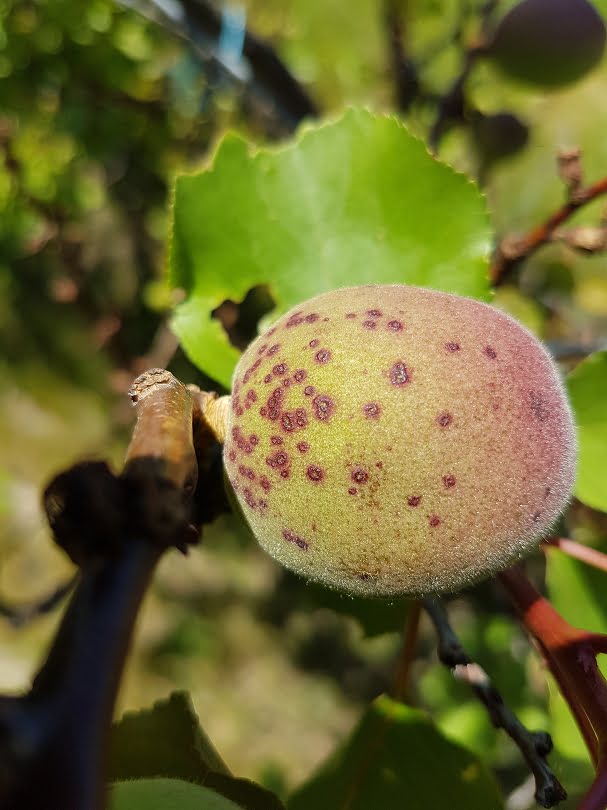
Freckle is one of the many problems that can show up in your leaves.
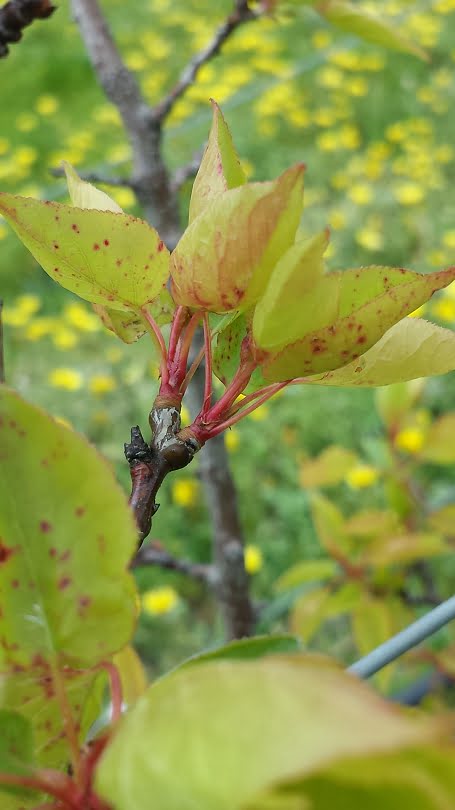
A really bad case will definitely downgrade an apricot from a “first” to a “second” grade. This is usually just a cosmetic problem that affects the skin, and the fruit underneath will be perfectly good to eat and delicious.
It’s just one of a number of fungal diseases that can affect different types of fruit. It’s preventable with a spray regime using organic fungicides, as well as good hygiene practices.
Give us some good news …
Apricots are not all bad news. Here’s a great example of how resilient your apricot tree can be, and how it can turn something bad into something good.
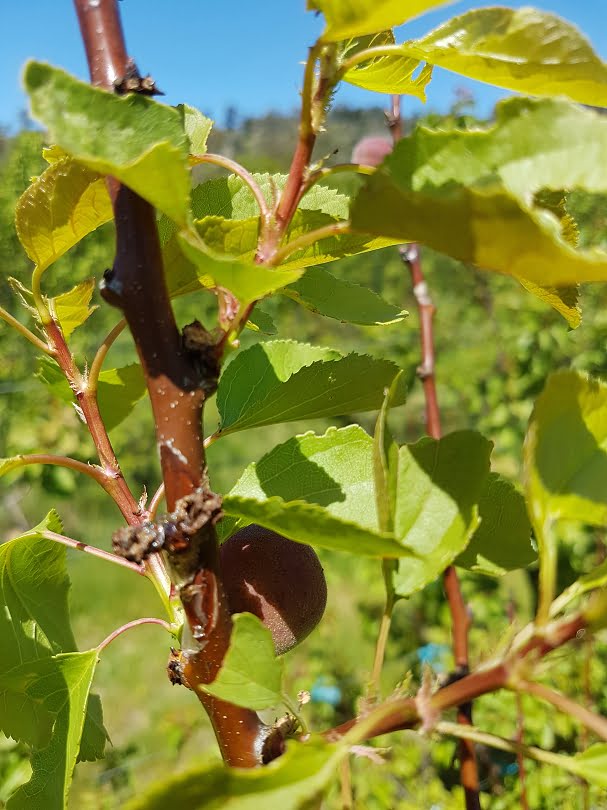
You can see the remnant evidence of Blossom blight on this shoot (above). First, the flowers rotted and died, and then the shoot also died back.
But the tree has managed to isolate the disease and stop it from spreading any further back towards the trunk, by isolating it with a blob of gum. Then it’s grown three magnificent new, strong shoots – healthy new growth to replace the old!
Apricots are fussy, but they’re also tough and you should definitely persevere with your apricot trees.
This is particularly true because they are one of those fruits that suffer most from modern picking and storage techniques.
It’s hard to find that “home-grown” deliciousness when you buy them off the shelf. Taking the time to upskill your apricot tree care and knowledge will definitely pay off in the long term!
Related Articles
How to avoid leaf curl by watching for spring
Learning how to avoid leaf curl is all in the timing. The key time to pay attention is very early spring, earlier than you think!
Should you replant a fruit tree in the same hole?
Sometimes fruit trees have to be replaced. Learn how to replant a fruit tree safely and avoid the pitfalls of replant disease.
How To Grow Almonds
Almonds are a beautiful and easy-care tree to include in your garden, with nuts that are delicious and protein-rich.

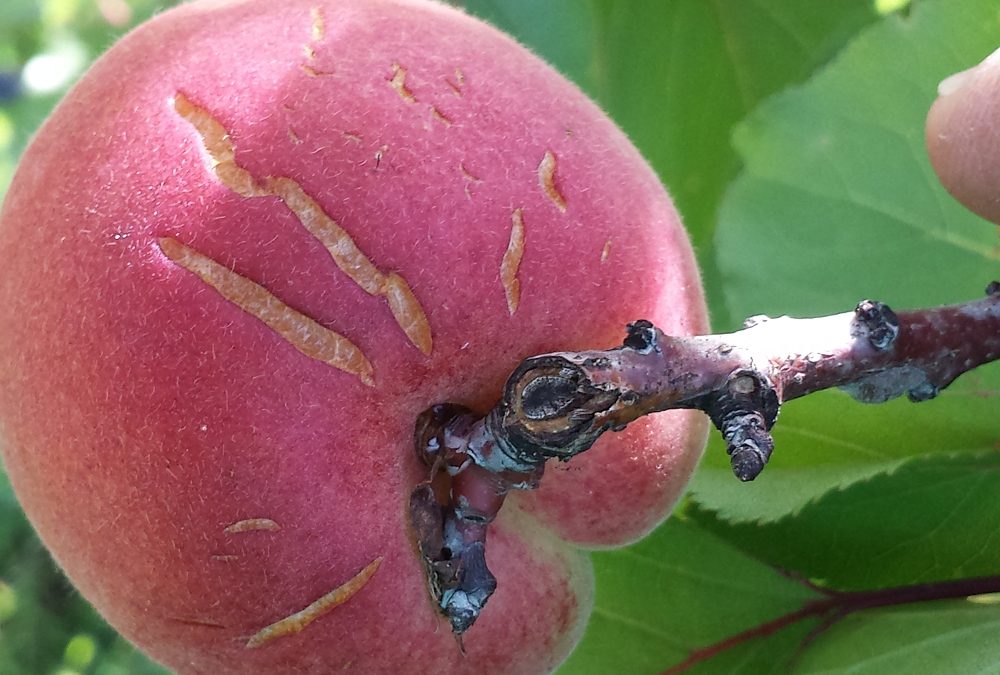


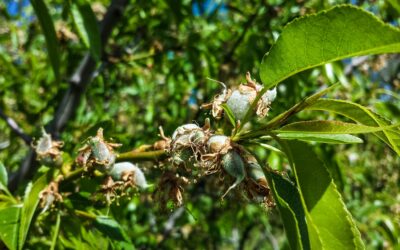
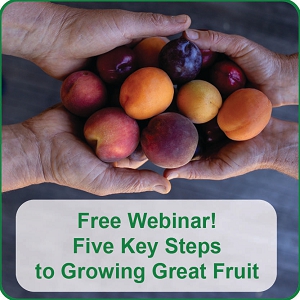
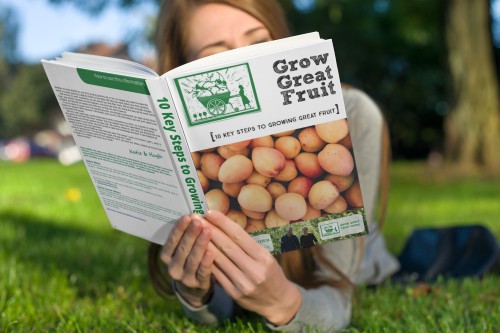
Just wondering if you have any ideas to stop dieback of leaves on my pear ,plum and apricot trees. Tips turn brown then whole leaf dies and falls.Its a major problem atm.
Hi Prim, there are lots of things that might be causing these symptoms, from nutritional problems, to over-watering, to various diseases, or even insects! I’d suggest you start with our e-book “What’s That Spot”, and see if you can find some photos that look similar to the symptoms you’re experiencing. This is also the exact sort of problem we help our Grow Great Fruit members with, so you might be interested to look at that program as well. Good luck with your trees!
hi,
Cant work out why my to apricots one of which is a moorpark the other Ive forgotten have been in two years and I have had probably 3 or 4 apricots from these trees.. They have been well,pruned not overwatered and sprayed at the right times..I’m very puzzled..
Hi Robbie, in the first couple of years the tree is busy putting its energy into growing the branches it needs rather than growing fruit – in fact we don’t usually let our trees have any fruit until they’re at least 3 years old, or until the “establishment pruning” phase is over, i.e. when you can look at the tree and see that all the framework branches are established in the right place. Once they’re in place you can ease back on the hard pruning, and let the tree settle down and start fruiting. If it’s flowering well but not fruiting then you need to do some detective work to figure out whether it’s frost, disease or lack of pollination that might be causing the problem.
I have yellow peach trees and I do early spraying but once the fruit starts to set
I get leaf curl all over the tree what else can I do to prevent this from happening
next season.
Hey Vincenzo, we have another blog about leaf curl and how to prevent it – here’s the link: https://growgreatfruit.com/how-to-prevent-leaf-curl/
Our Apricots as they ripen are rotting litggkke black bugs appear in the fruit
Hi Brenda, yes they will be carpophilus beetle, very annoying little bugs. We explain more about them and how to prevent them in this course – https://growgreatfruit.com/product/protect-fruit-from-pesky-pests/
Hi there, our fruit has been affected pretty heavily by freckly fungus this year and we are wanting to make an apricot jam out of it? Do you know if there are any issues with using very freckled fruit for a jam? Is it ok to eat?
Thanks!
Hi Joseph, it’s been a shocker of a year for freckle this year because it’s been so wet. Yes, they’re fine to use for apricot jam, the fruit is still completely fine to eat, you might just want to peel the skin first if they’re really ugly. Happy jam-making!
I have a 5 year old Apricot tree. It doesn’t produce a lot of fruit, but does produce some. This year it has a fuller crop but the foliage is not very robust. It seems to be lacking leaves
Any thoughts?
Hi Mike, if your tree is flowering adequately, then the two main reasons for the lack of crop in apricots are frost, and disease (mainly a nasty disease called blossom blight – we explain how to prevent it in this short course – https://growgreatfruit.com/product/keep-your-fruit-trees-free-from-disease/). However the poor foliage, and if the tree is not flowering well both point to nutritional issues, so we’d suggest giving it a good feed!
Hi
I have some sap leaks and occasionally a smaller branch dies off of my apricot. I don’t think it is borers because usually I can dig them out. What do you think it is and what would you suggest to do?
Thanks
Larry
Hi Larry, there’s a couple of possibilities – the main one is a disease called Blossom blight, which is fungal. Another is a bacterial disease called Bacterial spot. Both are described, with the appropriate treatments, in this short course – https://growgreatfruit.com/product/keep-your-fruit-trees-free-from-disease/
We have apricots that taste bitter. Raw, not so bad, but cooked or freeze dried bitter. What is happening to these apricots?
I have a what’s supposed to be miniature apricot tree in a pot I must admit it hasn’t been that well looked after It fruits well with a good crop but as they ripen they get these large dark spots, they don’t rot, they just shrivel up on the tree I don’t think it’s brown rot as it stays just on the skin and the fruit inside is delicious but they just shrivel as they ripen I’m not sure if they are ok to eat
Hi Yvonne, are there any other signs of disease on the tree? E.g. oozing sap, cankers, blossom blight? It’s probably fine to eat the fruit if they are delicious as you say, but definitely worth getting to the bottom of whatever is going on so that you can help your tree thrive. Thanks, Meg – GGF team.
Hi I’ve been in this house since 2014 and the apricot tree was all ready here. In the first few years I had over 100 kg and as time has gone buy I’m getting less every year.This year I will be lucky to get 5 kg some good size fruit have been dropping off and are totally green . I was told to give it a savage prune ie ( a chainsaw) not to the truck but the branches. I don’t want to do that until I’m sure it will work.
Hope you can help. Cheers Dale
Hi Dale,
There could be a few things going on – are there any signs of disease on the tree? Has anything changed in the garden ecosystem since 2014? And what sort of pruning regime have you had? I’d suggest starting with our pruning resources to see if that might help – renovation pruning, and general pruning advice. Make sure you read the renovation pruning info before you grab the chainsaw! Hope that helps, Meg – GGF team.
Hello, I’m hoping you might be able to help me. My apricot tree is 8 years old and it produces lots of apricots, however this year and last the fruit has a fine white vein ruining through its flesh. It comes groom the seed and ruins the fruit. It makes you gag when eating it. I have tried stewing it, jam and dehydrating but it is all uneatable. I am puzzled as to what this is and have no idea why it’s just started to happen? I would love any direction/ suggestions. Thanks, Kim
Can you grow a dwarf and also can you grow one in a pot in a glass enclosure
Hi Irene, Dwarfing trees are available for most types of fruti – you specifcially need to look them though. Our ebook on growing fruit trees in pots may be of interest. Cheers.